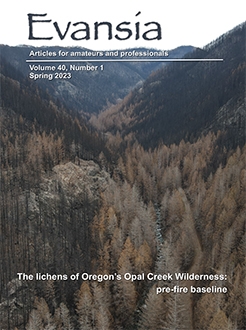Morphological identification of Chaenotheca phaeocephala and Chaenotheca subroscida in the Pacific Northwest is difficult. Both have stalked mazaediate ascomata with yellow pruina and ascospores that are relatively large for the genus. In Scandinavia, their thalli are distinguishable and they occur in different habitats. We used thin-layer chromatography to examine the secondary metabolites in thalli of 36 specimens from Oregon and Washington identified as C. phaeocephala or C. subroscida. Nine specimens contained pseudoplacodiolic acid, which places them in C. subroscida. The thalli of six of these had dense whitish granules and no verrucae; other specimens had a mixture of verrucae and white granules. The rest of the specimens did not have pseudoplacodiolic acid and were therefore C. phaeocephala; their thalli had varying amounts of verrucae and granules. Our results suggest that identification of these two species in the Pacific Northwest is not possible without TLC.
How to translate text using browser tools
8 August 2023
Chaenotheca subroscida and C. phaeocephala in the Pacific Northwest of North America
Claire Morris,
Daphne Stone
ACCESS THE FULL ARTICLE

Evansia
Vol. 40 • No. 1
Spring 2023
Vol. 40 • No. 1
Spring 2023
calicioids
Lichens
pseudoplacodiolic acid
TLC




